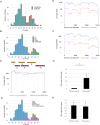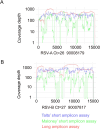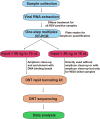An Improved Rapid and Sensitive Long Amplicon Method for Nanopore-Based RSV Whole-Genome Sequencing
- PMID: 40296507
- PMCID: PMC12037990
- DOI: 10.1111/irv.70106
An Improved Rapid and Sensitive Long Amplicon Method for Nanopore-Based RSV Whole-Genome Sequencing
Abstract
Background: Whole-genome sequencing (WGS) provides critical insights into the respiratory syncytial virus (RSV) transmission and any emerging mutations that could impair the efficacy of monoclonal antibodies or vaccines that have been recently licenced for clinical use worldwide. However, the ability to sequence RSV genomes at large scale is limited by expensive and time-consuming sequencing methods. Oxford Nanopore Technology (ONT) offers significant improvements in next generation sequencing (NGS) both in turnaround time and cost, compared with other platforms for viral WGS.
Methods: We have developed and modified an RSV long amplicon-based WGS protocol for the ONT platform using a one-step multiplex RT-PCR assay and the rapid barcoding kit. One hundred thirty-five RSV positive Australian clinical specimens (91 RSV-A and 44 RSV-B) sampled in 2023 with cycle threshold (Ct) values between 14 to 35 were tested in this study. This ONT workflow was compared with other recent RSV WGS amplification assays based on short amplicons.
Results: A PCR amplicon clean-up step prior to library preparation significantly improved WGS result for samples with poor amplicon generation, but it is not necessary or beneficial for ones that generated high concentrations of amplicons. Overall, a success rate of 85.9% was achieved for WGS. This method performed as well as the more complex short amplicon methods in terms of genome coverage and sequencing depth.
Conclusions: The workflow described here was highly successful in generating RSV WGS on ONT platform and had improved turnaround times and excellent results with RSV clinical samples with Ct values up to 30.
Keywords: ONT; rapid barcoding; respiratory syncytial virus; whole‐genome sequencing.
© 2025 The Author(s). Influenza and Other Respiratory Viruses published by John Wiley & Sons Ltd.
Conflict of interest statement
The authors declare no conflicts of interest.
Figures




Similar articles
-
A simplified, amplicon-based method for whole genome sequencing of human respiratory syncytial viruses.J Clin Virol. 2023 Apr;161:105423. doi: 10.1016/j.jcv.2023.105423. Epub 2023 Mar 12. J Clin Virol. 2023. PMID: 36934591
-
Robust and sensitive amplicon-based whole-genome sequencing assay of respiratory syncytial virus subtype A and B.Microbiol Spectr. 2024 Apr 2;12(4):e0306723. doi: 10.1128/spectrum.03067-23. Epub 2024 Feb 27. Microbiol Spectr. 2024. PMID: 38411056 Free PMC article.
-
Development of a culture-independent whole-genome sequencing of Nipah virus using the MinION Oxford Nanopore platform.Microbiol Spectr. 2025 Jun 3;13(6):e0249224. doi: 10.1128/spectrum.02492-24. Epub 2025 Apr 16. Microbiol Spectr. 2025. PMID: 40237504 Free PMC article.
-
RSV-GenoScan: An automated pipeline for whole-genome human respiratory syncytial virus (RSV) sequence analysis.J Virol Methods. 2024 Jun;327:114938. doi: 10.1016/j.jviromet.2024.114938. Epub 2024 Apr 6. J Virol Methods. 2024. PMID: 38588779
-
Development and evaluation of a next-generation sequencing methodology for measles virus using Oxford Nanopore Technology.J Clin Microbiol. 2025 Mar 12;63(3):e0145624. doi: 10.1128/jcm.01456-24. Epub 2025 Feb 4. J Clin Microbiol. 2025. PMID: 39902875 Free PMC article.
References
-
- Shi T., McAllister D. A., O'Brien K. L., et al., “Global, Regional, and National Disease Burden Estimates of Acute Lower Respiratory Infections due to Respiratory Syncytial Virus in Young Children in 2015: A Systematic Review and Modelling Study,” Lancet 390, no. 10098 (2017): 946–958. - PMC - PubMed
Publication types
MeSH terms
Grants and funding
LinkOut - more resources
Full Text Sources
Medical

